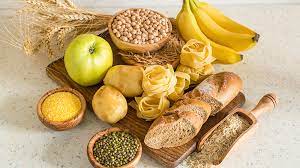Carbohydrates
Carbohydrates are the organic compounds i.e. essential biomolecules composed of carbon ,hydrogen and oxygen. The hydrogen and oxygen are in the ratio of 2:1 so they are also called "Hydrates of C...

Water (H2O):
Water is the mother liquor of all forms of life. It is the vital essence, miracle of nature, and the great sustainer of life. The essentiality of water for the living system is quite evident without water, there is no life. In human adult total body water accounts for about 70% of the lean body mass. In-plant it makes about 70%-90% of the living matter of active cells. In many hydrophytes and fruits, water appears in an even high percentage. A greater portion of water is found in free form that means the water which is available for the metabolic process.
General properties of water:
1.Expansion on freezing: most substance decreases in volume and hence increases in density as their temperature decrease. But in the case of water, there is a temperature at which its density exceeds that at higher or lower temperatures. This temperature is 40C. In fact, water just above the freezing point is heavier than water at the freezing point. Which makes it easier to live those organisms at the bottom of the lake.
2. Uniquely high surface tension: like a stretched membrane, the surface of a liquid tends to contract as much as possible. This phenomenon is called surface tension. Water has the highest surface tension of 72.8 of any known liquid. And it is the reason why water rises to unusually high levels in narrow capillary tubes. This has great significance in physiology.
3.High solvent power: water is a solvent for a great number of the molecule which forms ionized solutions in water. It may, thus, be called a universal solvent that facilitates chemical reactions both outside of and within biological systems.
4. Uniquely high heat capacity: There occurs a smaller temperature rise in water as compared to most other substances when a given amount of heat is applied. Thus, water acts as a temperature buffer. It maintains its temperature more successfully than most other substances.
Function of water i)Water is a universal solvent.
ii) It is used as a raw material in photosynthesis.
iii) It also helps in transpiration due to turgor pressure.
Iv) It also maintains the turgidity of cells and their organelles.
Minerals
Minerals are the inorganic substances that are essential for the growth and development of the living organism. Those minerals which are essential for the growth and survival of organism are called essential elements. Some minerals are required in a high amount for growth and are called macronutrients. The macronutrients are calcium, nitrogen, phosphorus, sodium, chlorine, magnesium, and sulfur. Some minerals are required in small amounts and they are called micronutrients. The micronutrients are iron, copper, cobalt, zinc, manganese, molybdenum, fluorine, iodine, and selenium. Types:
Macro and Micro-nutrients
Macro-nutrients
The plant-based nutrients are required in large quantities as our body cannot produce by its self. These macro-nutrients providing energy and supports the different metabolic system, growth, and development of the body. Macro-nutrients include fats, proteins, carbohydrates, vitamins, and minerals.
Micro-nutrients
The plant-based nutrients which are required in very small quantities and are mainly responsible for repairing damaged cell and tissues, prevention of infectious diseases by fighting against the disease-causing pathogens including bacteria, virus, fungi, etc. Micro-nutrients include calcium, iron, vitamins, iron, minerals, and vitamin C.
Difference between Micronutrients and Macro-nutrients
Following are the important difference between macronutrients and micronutrients:
Micro-nutrients | Macronutrients |
Requirements |
|
Required in minute quantities. | Required in large quantities. |
Functions |
|
Play a crucial role in the prevention of diseases. | Play a crucial role in providing energy. |
Consequences of Deficiency |
|
Deficiency results in Anemia, Scurvy, Goiter, etc. | Deficiency results in Malnutrition, Kwashiorkor, marasmus, etc. |
Consequences of Overconsumption |
|
Overconsumption of Vitamins leads to liver and nerve damage. | Overconsumption of macro-nutrients results in cardiovascular diseases, diabetes, obesity, etc. |
Concentration |
|
Available in a minute inside the body. Less than 1 mg/gm. | Available in high concentration inside the body. Equal to 1 mg or 1000 microgram. |
Composition |
|
Also called trace elements. | Also called as major elements. |
Types |
|
vitamins, minerals, and trace elements. | carbohydrate, protein, and fats. |
Examples |
|
Antioxidants, Minerals, and Vitamins are examples of macro-nutrients. | Proteins, fiber, carbohydrates, and fats are examples of micro-nutrients. |
Sources |
|
Are found in vegetables, fruits, eggs, green leafy vegetables, fermented foods, etc. | Are found abundantly in cereals, legumes, meat, fish, yams, potatoes, nuts, oilseeds, etc. |
Advantages |
|
Micro-nutrients contribute to body growth and disease prevention. | Provides energy required for the metabolic system. |